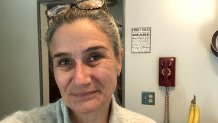Since September of 2019, Laura Ward of Avon has battled the inflammatory disease pulmonary sarcoidosis in her lungs.
“I am at higher risk of catching things like the flu and COVID and if I do, my symptoms would most likely be on the severe side,” she explained.
In November, she found out that her upcoming appointment to see her pulmonologist in person would be canceled due to COVID.
“I’m still finding my way with the disease and trying to figure out how it’s manifesting itself in me and so that stethoscope on my chest is something that’s really important to me,” said Ward, who last got that reassurance in June.
This time, she was offered a virtual visit instead.
“Our health insurance puts our copay at a point where it’s pretty significant and if I wasn’t going to be able to walk away with the one thing that really reassures me at my doctor’s visits, it was just going to be a conversation and not necessarily needed to take place,” said Ward.
Ward said she wasn’t told why the decision was made but the office expressed that other patients shared her concerns about the need for in-person visits.
“I don’t know if it was for the doctor’s personal safety or if it was a system-wide decision in that particular practice,” she explained.

Seniors Struggle the Most With 'Digital Divide'
Local
According to AARP, virtual visits rose 300% among those eligible for Medicare during the pandemic.
“But the concern for us is that 26% of Medicare beneficiaries lack access at home,” said Nora Duncan, AARP Connecticut State Director. “The affordability issue is one that is I think probably the most concerning.”
One Connecticut expert on aging likens the digital divide among seniors to the problem plaguing students in underserved communities.
“People just don’t have access to the technology at all, can’t afford a laptop, don’t have a smartphone,” said Maureen McIntyre, CEO of North Central Area Agency on Aging.
Connecticut’s five agencies on aging are using federal CARES Act dollars to put that technology into the hands of older adults.
“Telehealth has been a very valuable tool in getting people the care they often can’t access otherwise,” said McIntyre specifically pointing out the transportation issues more prevalent with this age group.
AARP reports that 50% of those surveyed said they felt comfortable using a smartphone or computer for a virtual visit. For the other half who don’t know how to use a computer or don’t have access to the internet, the consequences during COVID and beyond could be dire.
“We are absolutely seeing people delaying that kind of in-between care, the stuff that can’t be done over the phone,” said McIntyre. “Are there conditions that are not being addressed because those early symptoms weren't caught?"
Looking for Legislative Solutions
House Minority Leader Vinnie Candelora agreed that telehealth, while beneficial to some, isn’t covering all of the gaps created by COVID.
“Wellness visits and checks of that nature really need to be in person,” he said, pointing out that only so much can be done through a conversation over the computer.
He said two dozen constituents have reached out to his office with concerns about telehealth, including not being able to keep mammogram and colonoscopy appointments.
“Everybody is cheering the benefits and I want to be the voice to say 'hold on a minute, there’s another side to this story,'” he said.
That side he said has as much to do with the economics as access.
“I think something is being lost. If we’re rewarding the telehealth services as the same financial level as an in-person visit, I think we might see healthcare going in the wrong direction,” said Candelora.
Candelora explained that when the pandemic caused the state shutdown, lawmakers changed the reimbursement rate so that doctors could bill the same amount for a virtual visit as a traditional office appointment.
“We can’t have telehealth replace our in-person visits,” said Candelora. “When we could not open our facilities, it did make sense but going forward, I think there should be different financial rewards. A wellness visit in person should not have the same billing rate as a telehealth service.”
Candelora wants to see the issue rectified during this legislative session.
One benefit of the pandemic that some hope doesn’t change is the state-required insurance coverage for virtual visits, set to expire in March.
“Obviously, with telehealth, there are a lot of things that can’t be done,” said McIntyre. “For folks who are able to use telehealth, it’s been a huge benefit.”
Duncan said the AARP will lobby lawmakers this legislative session to expand broadband access as well.
“I think the issue of affordable, reliable broadband access for everyone is really the thing moving forward,” she said.
Still Waiting for that Peace of Mind

Ward said she respects her doctor’s decision.
“I understand that everyone has to do what they feel is safest and what is best for them and healthcare providers included,” she explained.
She considered looking for a new doctor but said, for now, she’s taking a wait-and-see approach, hoping to reconnect with her current provider soon.
“It is that face-to-face touchpoint and the ability for the doctor to listen to my heart and lungs that really puts me at ease,” said Ward.



